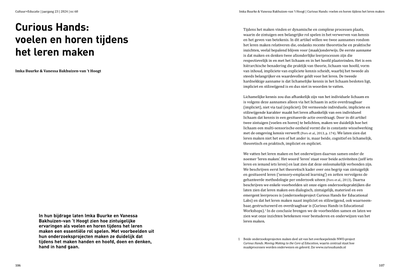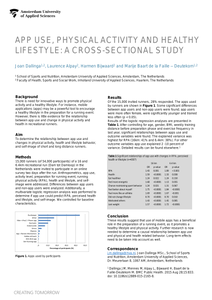In hun bijdrage laten Imka Buurke en Vanessa Bakhuizen-van ’t Hoogt zien hoe zintuigelijke ervaringen als voelen en horen tijdens het leren maken een essentiële rol spelen. Met voorbeelden uit hun onderzoeksprojecten maken ze duidelijk dat tijdens het maken handen en hoofd, doen en denken, hand in hand gaan
MULTIFILE

Radio interview met Marije Baart de la Faille-Deutekom over het effect van apps op hardlopers
LINK
This relationship between external knowledge providers, e.g. consultants and academic institutions, and small and medium enterprises (SMEs) is a difficult one. SME entrepreneurs think external advice is expensive, not required and/or not useful. In this paper these arguments are explored against the specific characteristics of SMEs. The argument of price probably tells more about the consultants inability to quantify the returns on their advice than about the cost of their services. Support policies enable free consults for SMEs on numerous topics, but the use of these facilities is relatively low. The suggestion that SME entrepreneurs do not need external knowledge is contradicted by their own assessment of their qualities. Typically the entrepreneurs lack expertise in supporting business functions like HR, IT, Finance and Legal. In SMEs these blank spots are not compensated by specialist staff members because the of the scale of the organization. The argument that the advice of an external consultant is generally not useful raises the question whether the insights gained in several business sciences only apply to large companies. This seems unlikely. Given the characteristics of SMEs the difference is probably more the context in which the insights are applied than the content of the insights itself. From the analysis of the characteristics of SMEs the dominant influence of the person of the owner/director, together with the absence of specialist staff, appeared as two of the most significant differences between SMEs and large companies. Given the personal profiles of these owners/directors as studied by Blom (Blom, 2001), the external knowledge providers should realize the three ways in consulting. The first way is the way of thinking. For this way it was stated already that the content of business sciences is not likely to differ for SMEs. The second way, the way of working, represents for the way information is gathered and the entrepreneur and his staff is involved in the process of developing the advice. In this way the consultant should allow for interaction and should make it fun for the participants. In this aspect, the process approach of consulting shows promising. The third way, the way of communicating, represents the way the knowledge is transferred from the advisor to the entrepreneur. In this way it is crucial to acknowledge the different personal profiles of SME entrepreneurs and consultants and to adjust the communication accordingly. Taking the three ways into account, the conclusion could be that the transfer of knowledge should be more the sharing of experiences. The Chair of Management Consulting will adjust her activities to explore this insight further.
DOCUMENT

Full text via link. De folkband Pater Moeskroen bezong in 1991 moeders instructies voor de risicovolle tocht van ‘Roodkapje’ naar haar oma met het openbaar vervoer in de grote stad. Roodkapje zelf bleef rustig, net zoals reizigers van het Gemeentelijk Vervoerbedrijf (GVB) in Amsterdam dat nu ook doen.
LINK
In deze presentatie wordt gekeken naar de relatie tussen het gebruik van mobiele applicaties en fysieke activiteit en gezonde leefstijl. Dit is gedaan op basis van een vragenlijst onder deelnemers aan een hardloopevenement, de Dam tot Damloop. Er werden aparte analyses gedaan voor 8km lopers en 16 km lopers. Een positieve relatie werd gevonden tussen app gebruik en meer bewegen en zich gezonder voelen. App gebruik was ook positief gerelateerd aan beter voelen over zichzelf, je voelen als een atleet, anderen motiveren om te gaan hardlopen en afvallen. Voor de 16 km lopers was app gebruik gerelateerd aan gezonder eten, zich meer energieker voelen en een hogere kans om het sportgedrag vol te houden. De resultaten van dit onderzoek laten zien dat app gebruik mogelijk een ondersteunende rol kunnen hebben in de voorbereiding op een hardloopevenemen, aangezien het gezondheid en fysieke activiteit stimuleert.
DOCUMENT

In deze presentatie wordt gekeken naar de relatie tussen het gebruik van mobiele applicaties en fysieke activiteit en gezonde leefstijl. Dit is gedaan op basis van een vragenlijst onder deelnemers aan een hardloopevenement, de Dam tot Damloop. Er werden aparte analyses gedaan voor 8km lopers en 16 km lopers. Een positieve relatie werd gevonden tussen app gebruik en meer bewegen en zich gezonder voelen. App gebruik was ook positief gerelateerd aan beter voelen over zichzelf, je voelen als een atleet, anderen motiveren om te gaan hardlopen en afvallen. Voor de 16 km lopers was app gebruik gerelateerd aan gezonder eten, zich meer energieker voelen en een hogere kans om het sportgedrag vol te houden. De resultaten van dit onderzoek laten zien dat app gebruik mogelijk een ondersteunende rol kunnen hebben in de voorbereiding op een hardloopevenemen, aangezien het gezondheid en fysieke activiteit stimuleert.
DOCUMENT

Wat kan een reguliere school doen om ook slechthorende kinderen onderwijs te kunnen geven, in een klimaat waarin deze kinderen zich prettig voelen en tot hun recht komen? Inclusief onderwijs betekent dat elk kind de mogelijkheid krijgt om effectief onderwijs te volgen in de eigen buurt, waarbij verschillen tussen kinderen worden gewaardeerd en gerespecteerd. Bij inclusief onderwijs kan elk kind zijn of haar capaciteiten volledig ontplooien. Dat zou dus ook voor slechthorende kinderen moeten gelden. Maar is inclusief onderwijs voor deze groep mogelijk, terwijl recht wordt gedaan aan hun bijzondere communicatiebehoefte? In dit dossier vind je een interview met Annemiek Voor in 't Holt over dit onderwerp. Daarnaast biedt haar achtergrondartikel "Westervoort Inclusief. Een fictieve inclusieve school met dove en slechthorende leerlingen" tal van handvatten waarmee leerkrachten van diverse schooltypen hun onderwijs toegankelijk kunnen maken voor kinderen met een gehoorverlies. Ook vind je verschillende instrumenten waarmee je zelf als horende leraar een indruk kunt krijgen wat jouw slechthorende leerling(en) hoort, en vooral: wat niet. Door een blaffend hondje wordt in een powerpointboekje uitgelegd hoe het oor in elkaar zit, leuk om met de klas eens te bekijken. Op de pagina Voor kids: zo werkt je oor zijn ook nog handige links voor kinderen te vinden. Met een checklist kun je nagaan in hoeverre je zelf daadwerkelijk een actieve luisteraar bent.
DOCUMENT

Anticipatory force planning during grasping is based on visual cues about the object’s physical properties and sensorimotor memories of previous actions with grasped objects. Vision can be used to estimate object mass based on the object size to identify and recall sensorimotor memories of previously manipulated objects. It is not known whether subjects can use density cues to identify the object’s center of mass (CM) and create compensatory moments in an anticipatory fashion during initial object lifts to prevent tilt. We asked subjects (n=8) to estimate CM location of visually symmetric objects of uniform densities (plastic or brass, symmetric CM) and non-uniform densities (mixture of plastic and brass, asymmetric CM). We then asked whether subjects can use density cues to scale fingertip forces when lifting the visually symmetric objects of uniform and non-uniform densities. Subjects were able to accurately estimate an object’s center of mass based on visual density cues. When the mass distribution was uniform, subjects could scale their fingertip forces in an anticipatory fashion based on the estimation. However, despite their ability to explicitly estimate CM location when object density was non-uniform, subjects were unable to scale their fingertip forces to create a compensatory moment and prevent tilt on initial lifts. Hefting object parts in the hand before the experiment did not affect this ability. This suggests a dichotomy between the ability to accurately identify the object’s CM location for objects with non-uniform density cues and the ability to utilize this information to correctly scale their fingertip forces. These results are discussed in the context of possible neural mechanisms underlying sensorimotor integration linking visual cues and anticipatory control of grasping.
LINK